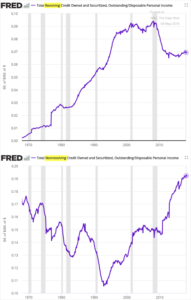
Image: americanprogress.org
The Federal Reserve just reported that consumer debt related to auto and student loans are at the highest level they have ever been since 1970 (2nd chart). As we have noted wages have stagnated since the Great Recession with 90 % of the income gains going to the top 10 % in income. The middle class has been left out of the mainstream of the economic recovery over the past 10 years.

Sources: The Federal Reserve Bank – St. Louis, The Wall Street Journal, The Daily Shot – 5/8/18
While revolving debt from credit cards has fallen (top chart) since the recession, non revolving debt for autos and student loans has soared. Consumers are caught in a squeeze between debt and flat wages. The Commerce Department reported on 1st Quarter GDP noted that consumer spending had decelerated during the quarter. Sentiment surveys have also shown a reduction in buying plans due to trade issues and any benefit from the tax cuts being lost due to rising prices from tariffs. Banks have posted 7 straight months of an increasing percentage of charge offs on bad loans where consumers are not making payments on non-mortgage debt.
As interest rates go up, payments grow larger per month, with the added tightening of increased prices. The middle class is caught trying to maintain their standard of living by borrowing money to mitigate flat wages.
Next Steps –
There are two sides to the squeeze – increasing wages and reducing loan payment size and principal.
We have endorsed Sen. Cory Booker’s bill called the Worker Dividend Act to share billions of dollars in stock buyback dollars 50/50 with employees. We see a need for incentives for employers to share management extreme wealth now at 300 times average worker salary with the line staff. Or if they can’t do it with incentives we like the City of Portland’s plan to require corporations share their funding above the 150 times level with employees. In our blog about why Wages Are Stuck we outline a series of steps including: placing workers on Boards, ending outsourcing overseas, end H1-B low wage visas, allow repatriated funds be brought back to the US only for wages, productivity or training investments, end stock buybacks and raise employee wages with the funds, breakup anti-competitive oligarchies of huge corporations to create more competition and jobs, balance the recruiting and hiring process for candidates, and offer incentives for employee training and development.
On the loan side, we recommend that student loan rates be brought back to reasonably fair rates as a percentage of the Fed Funds rate, and offer a series of forgiveness programs for universal service, community teaching and caregiving. For auto loans, we request that the Consumer Finance Protection Bureau evaluate major bank auto loans to ensure they are fair and do not have hidden fees or unusual interest rate riders.
